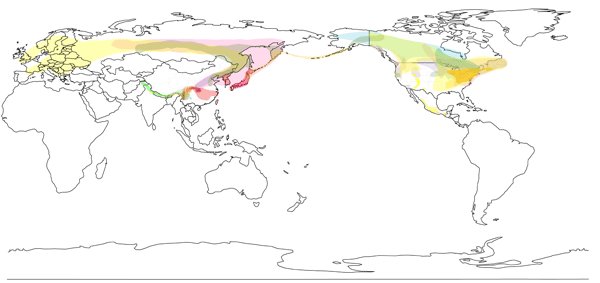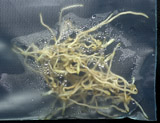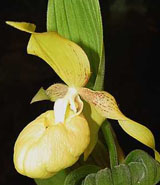
Description and Distribution of Cypripedium
Cypripedium was first used to describe the slipper orchids by Linnaeus in 1737. The name is derived from the island of Cypris, the birthplace of Aphrodite (Venus), and pedilum which refers to shoe or slipper. Thus, common names include Venus' Slipper and Lady's Slipper, or simply ladyslipper orchid. In Linnaeus' time into the 20th century, the genus Cypripedium included all the slipper orchids.

Map was drawn from a digital map from www.planiglobe.com. ©planiglobe 2004
Distribution of Cypripedium is confined to the northern temperate regions.
Today, the roughly 150 species of slipper orchids are all contained within the subfamily Cypripedioideae. The slippers have been divided into five genera. Cypripedium includes all of the temperate deciduous terrestrial orchids with plicate leaves and persistent perianth. Paphiopedilum contains Asiatic orchids with hard leaves, Phragmipedium contains South American species with hard leaves. Selenipedium is a genus of South American species with leaves similar to Cypripedium and many characteristics thought to be common in ancestral slipper orchids. Mexipedium contains a single species related to Phragmipedium.

The genus Cypripedium contains about 45 species of northern temperate terrestrial orchids. Today, about 30 species occur in China and 14 in North America. The western part of Europe has only a single species. Since more primitive relict forms of slipper orchids (Mexipedium, Selenipedium) exist in Meso America and North America it is thought that slipper orchids originated in the northern continental mass. Evidence suggests that evolution in Cypripedium has occurred from tall stems with many leaves and flowers to shorter stems with a single leaf and single flower.

Cypripedium is divided into ten sections; in section Subtropica the plants are tall with many flowers that are similar to the flowers of Selenipedium. In section Trigonopedia, plants have evolved to having essentially no aerial stem and a single leaf and flower.
Cultivation
In the Garden
Site
In siting your Cypripedium beds, keep in mind that Cyp's require about two hours of direct morning sun and dappled shade the remainder of the day. Afternoon sun will also work but may be harsh in mid and late summer if it does not become filtered by the leaves of tall trees as it sets. Noonday sun is not tolerated by any Cyp's with the possible exception of well-established Cyp. reginae, Cyp. candidum, or the Cyp. candidum hybrids such as Cyp. xandrewsii. Even for these relatively sun-loving species care must be taken to not let their roots become dessicated Thus, an ideal location would be a wood's edge that receives morning sun from the East or in front of a North-facing building or wall.
Once candidate sites are identified, one next examines the drainage of the site. Like any other orchid, Cypripedium will not tolerate a water- logged site. We recommend making specific beds for Cypripedium even if a single plant is being considered. We dig about 10 inches deep and discard the soil. Cypripedium, while "terrestrial," do not grow in dirt but rather the leaf litter and loose material, the "duff," of forest floors. Cypripedium roots are very shallow-growing, extending only 1 - 4 inches (2 - 10 cm) beneath the surface of the medium.
Growing Media
While many enthusiasts include soil as part of their growing medium and that works reasonably well for many American species, we find that most Cyp's and all Asian species, do much better over several years in artificial, inorganic media. Currently we use the following medium for our American species and have observed that our plants are all expanding numbers of stems much more rapidly than when we used soil-based media: Soil Perfector® : Soilmaster® : gravel : coir, 1 : 1 : 1 :1. If your site stays rather moist most of the time, coir should not be included.
For Asian species we do not include coir but instead use Soil Perfector® : Soilmaster® : gravel, 2:1:1. In our area where rain is reasonably frequent throughout the year, we dig fairly shallow beds, about 10 - 12 inches (25 - 30 cm) in depth and replace the soil with the growing media. In areas with many maple trees and their tangling roots, we often first line the excavated bed with 6 mil black plastic sheeting into which we have scribed a number of small slits to allow water to escape. When we used soil-based media we sometimes also lined the beds with hardware cloth to keep small, burrowing mammals such as voles away. However, the sharp-edged Soil Perfector® is effective in keeping these pests at bay.
Planting
Usually Cyp's are obtained in the fall or early spring as bare-root, dormant plants. Plants should have firm, off-white roots with few root tips missing. Growth buds should be prominent. If the roots are black or soft, there is little chance that the plant will survive. If some roots are in this condition but others appear normal, the dead and damaged roots should be cut away. The remaining rhizome and roots may survive. If buds are damaged or soft, they will likely be lost. However, if the rhizome is in good condition and there are intact roots, the plant will likely survive but it will have few or no aerial stems for a season or so while the plant recovers.
Plants should be placed in the media with their roots extending roughly parallel to the medium surface, only 2 - 4 cm deep. The depth of planting should result in the buds being at or within 1 cm from the medium surface. Remember that naturally occurring Cypripedium grow shallowly in the litter of the forest floor.
In Pots
Pot Culture of Mature Cypripedium
Pots for Warm Climates
Potted Cypripedium may be kept in situations in which temperatures are often high in the summer by growing them in pots with the ability to be cooled by evaporation. There are several ways in which to do this. A very simple method is based on the "zeer pot" method of placing one pot inside another in such a way that the outer pot is kept moist so that evaporation from it causes evaporative cooling of the inner pot.
You may download an Adobe Acrobat file with care instructions for mature Cypripediums.
Pot Culture of Cypripedium Seedlings
Cypripedium ladyslipper orchids originate from northern temperate climates. All of them grow during the summer, lose their leaves in the fall, and are dormant during the winter. Cypripedium seeds are very small and do not contain any nourishment. We collect seed, sterilize them on their outside surface using bleach, then grow them in sterile medium containing sugars, amino acids and vitamins in complete darkness for several months.
By this time the nearly microscopic seeds have grown 2 – 4 roots and 1 – 3 shoot buds. Once the shoot buds form the seedlings require a cold
dormant period that simulates winter, often referred to as vernalization. We accomplish this by removing the seedlings from their flask, washing
them carefully to remove all traces of growth medium,
 then storing them in small bags with a bit of water in a refrigerator for at least 4 months.
It is at this stage that you have acquired your seedlings.
then storing them in small bags with a bit of water in a refrigerator for at least 4 months.
It is at this stage that you have acquired your seedlings.
If you plan to keep your pots outside in a protected location, in mid–May the seedlings may be removed from their bags (earlier if you see that the shoot buds are beginning to grow noticeably). Because they are small, seedlings should be planted in a small flowerpot that contains a mixture of roughly equal proportions of perlite, Soilmaster® (available from Lesco stores as Pro's Choice Soilmaster) or Turface®, and natural aquarium gravel (the kind that has particles about the same size as the Soilmaster). If you cannot locate Soilmaster or Turface, use a mixture of 2 parts perlite to 1 part natural aquarium gravel of 1-2 mm diameter (or #3 filtration sand from your water softener company). We often use a 6 inch pot (azalea pots are ideal since the roots are shallow) for 6 first year seedlings. A pot this size will be adequate to grow the seedlings for 3 years until they are ready for beds outside in the garden.
Wet the media components in a bowl and mix thoroughly. Place a wire mesh over the drain holes in the pot, then add media. The seedlings should be planted so that the roots are roughly parallel to the media surface, with the buds just below the surface – do not plant too deeply!
Cypripedium seedlings must be kept moist – never let the media dry completely. This usually means a light watering every other day or so. For maximum growth, your seedlings should receive fertilizer every other watering. We recommend either Miracle Gro Bloom Booster® or Dyna-Gro® hydroponics fertilizer. Each of these contains a complete mixture of trace elements, which is important since your seedlings are growing in an artificial medium. We use both of these fertilizers at the rate of 1/4 teaspoon per gallon of water.

During their first year or two your seedlings should be in a bright location but should never receive direct sunlight. Once the seedlings reach 3 – 4 years of age, they enjoy about 2 hours of morning sunlight each day – never noonday sun.
In raising Cypripedium seedlings, the only difference fro tropical orchids is that Cypripedium must have winter. The easiest way to provide winter for potted plants is to make sure the medium is moist but not wet, then to place the pot into a plastic bag and into the refrigerator for 4 months (5 months is better for most Asian species except for Cypripedium formosanum which comes from a warmer climate). Make sure the pot is placed where the seedlings will not freeze and thaw. Alternatively, pots may be placed in an unheated garage or other area where temperatures will not change rapidly.
Cypripedium seedlings, like many orchids, mature slowly. While an occasional precocious seedling may bloom in its third year out of flask, most will require 5 years or so.
You may download an Adobe Acrobat file with these seedling care instructions.

